|
The E-mu mystery modules - updated.
(extracted from the E-mu Modular Synthesizer
section of Zappa's Gear)
FZ took delivery of his custom E-mu synth in
1976. It was one of the largest and most
complicated systems that they ever produced. It
was built into two 4100 walnut system cabinets,
each approximately 45” wide by 26” high;
containing the following modules:
|
Cabinet 1:
|
|
|
1 × 2000
|
Voltage Controlled Amplifier
|
|
1 × 2010
|
Quad Voltage Controlled Amplifier
|
|
2 × 2100
|
Voltage Controlled Low-Pass Filter
|
|
1 × 2110
|
Voltage Controlled High-Pass Filter
|
|
1 × 2120
|
Universal Active Filter
|
|
4 × 2140
|
Resonant Filter
|
|
3 × 2200
|
Voltage Controlled Oscillator (sine/triangle/sawtooth/pulse)
|
|
2 × 2210
|
Sawtooth/Pulse Voltage Controlled Oscillator
|
|
2 × 2350
|
Dual Delayed Transient (ADSR) Generator
|
|
2 × 2355
|
VCTG (Voltage Controlled Transient Generator) Input Unit
|
|
1 × 2400
|
Noise Source
|
|
1 × 2410
|
Sample & Hold
|
|
2 × 2430
|
Ring Modulator
|
|
1 × 2451
|
Potpourri Module – Summing Amp/Low Frequency Oscillator /Digital
Inverter/Comparator/Inverter
|
|
2 × 2455
|
Mixer (4 signal inputs, stereo output)
|
|
1 × 2800
|
Blank Panel
|
|
1 × 2905
|
2905 Power Supply with Keyboard Outputs
|
|
1 × 2906
|
2906 Multiple Panel (4×8 socket patch bay)
|
|
1 ×
|
Custom Output Mixer
|
|
1 ×
|
Unnamed module with 6 switches, 4 jack sockets and 8 trim pots.
This does not
look as if it
was made by e-Mu
as it uses
different
switches and
jack sockets,
which are poorly
lined up.
|
|
1 ×
|
Unnamed module with 3 switches, 6 jack sockets and 6 balanced
output
connectors.
|
|
|
|
|
Cabinet 2:
|
|
|
2 × 2010
|
Quad Voltage Controlled Amplifier
|
|
12 × 2210
|
Sawtooth/Pulse VCO
|
|
6 × 2100
|
Voltage Controlled Low-Pass Filter
|
|
3 × 2350
|
Dual Delayed Transient (ADSR) Generator
|
|
1 × 2355
|
VCTG (Voltage Controlled Transient Generator) Input Unit
|
|
1 × 2510
|
8 Position Address Generator
|
|
1 × 2520
|
Voltage Source Output Unit (combined with the 2510 this made one
of the world’s
first
sequencers)
|
|
1 × 2905
|
Power Supply with Keyboard Outputs
|
|
1 × 2906
|
Multiple Panel (4×8 socket patch panel)
|
|
1 × 4060
|
Keyboard Sequencer Output panel
|
|
1 ×
|
Unnamed module with 5 jack sockets, 11 control knobs (including 1
marked ‘Master
Filter’ and one
‘Chorus/Normal’).
|
Also included were two 4000 mono keyboards, and the new
4060 Polyphonic Keyboard and Sequencer. The
system was designed so that the two cabinets
could be operated independently if required;
Cabinet 1 as a traditional monophonic
synthesizer with an extensive range of sounds
and effects, and Cabinet 2 as a fully polyphonic
instrument with its 12 oscillators and sequencer
modules.
Towards the end of his life in June 1993, FZ donated the E-mu
to the
Musée de la Musique in Paris. The keyboards couldn’t be found when the synth
cabinets were shipped to France, and by the time
they turned up the museum had already built the
exhibit and said that they had no room for them,
so they were sold to a private collector.
However the two system cabinets are still prominently featured
on the wall of the 20th
Century music gallery. It seems fitting that
they are in the company of various percussion
instruments and two sirens which belonged to
FZ’s teenage inspiration, the innovative
composer Edgar Varese.
Three of the modules are unnamed, and the
Output Mixer in Cabinet 1 looks like a custom
unit. At least one of the others looks
'home-made' - E-mu would never have produced a
module with such misaligned switches and
connectors. See the pictures below for details.
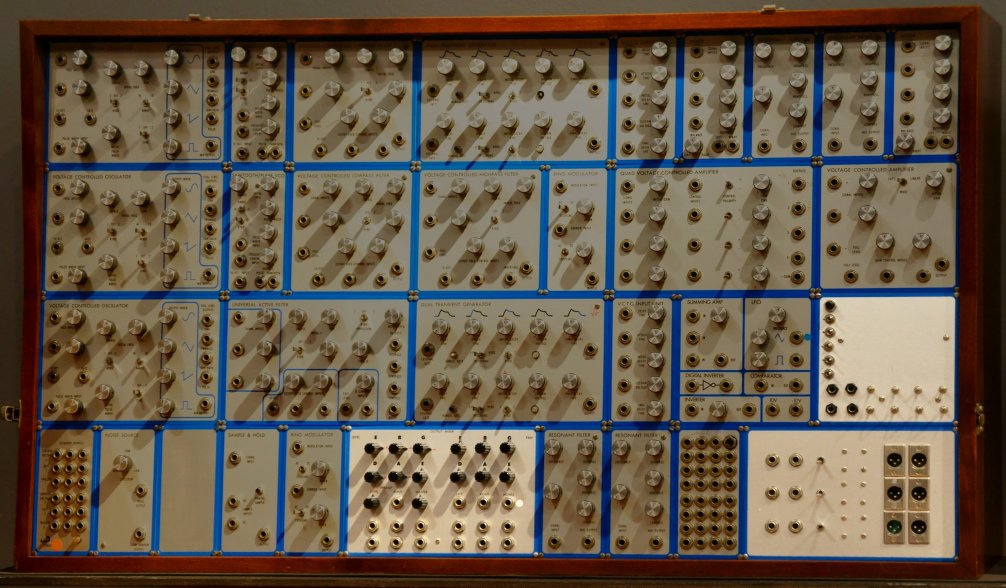
Cabinet #1,
highlighting the
Output Mixer and two
unnamed modules.
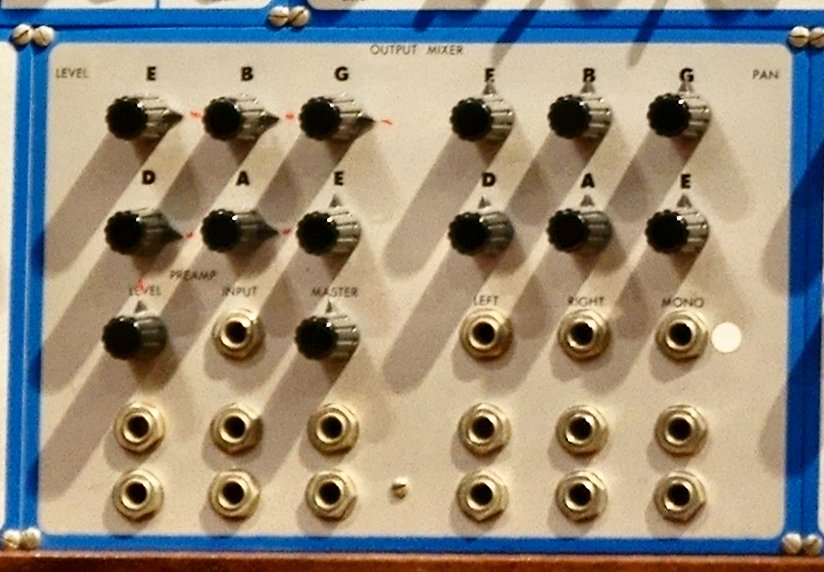
The 'Output Mixer'
doesn't look like an E-mu product; from the
lettering on the knobs (one for each guitar
string) this must have been an interface to a
guitar synthesizer/controller of some kind.
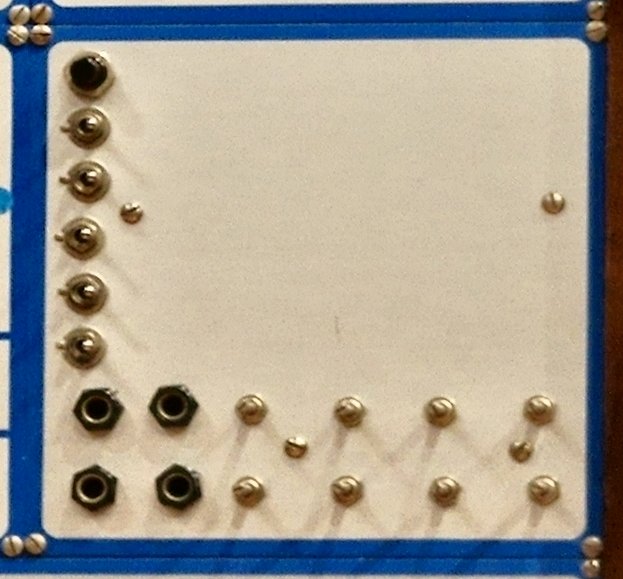
Mystery module 1 - note the misaligned switches
and sockets. Who made it?
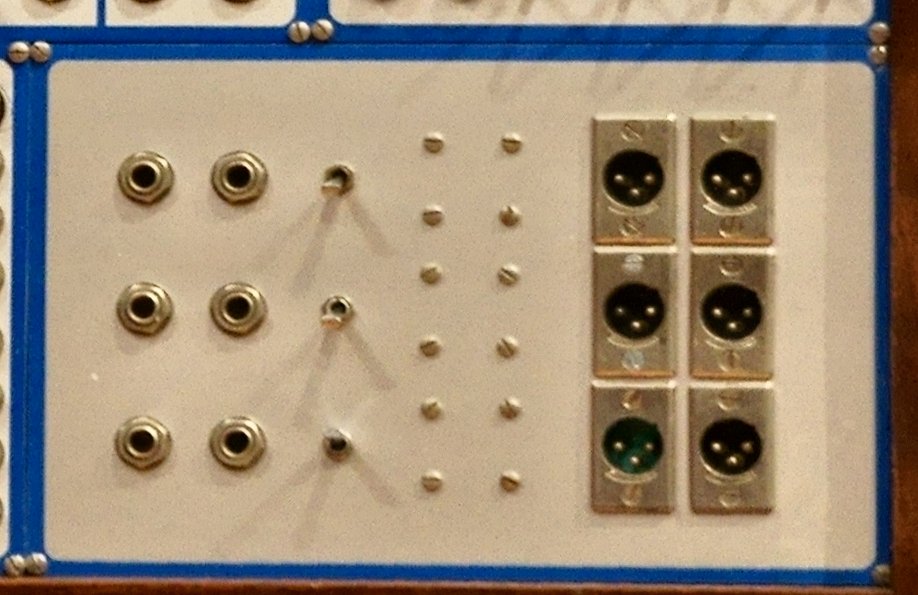
Mystery module 2 - some sort of input/output unit obviously,
Tommy Mars thinks this may have been a custom
interface for recording studio use.
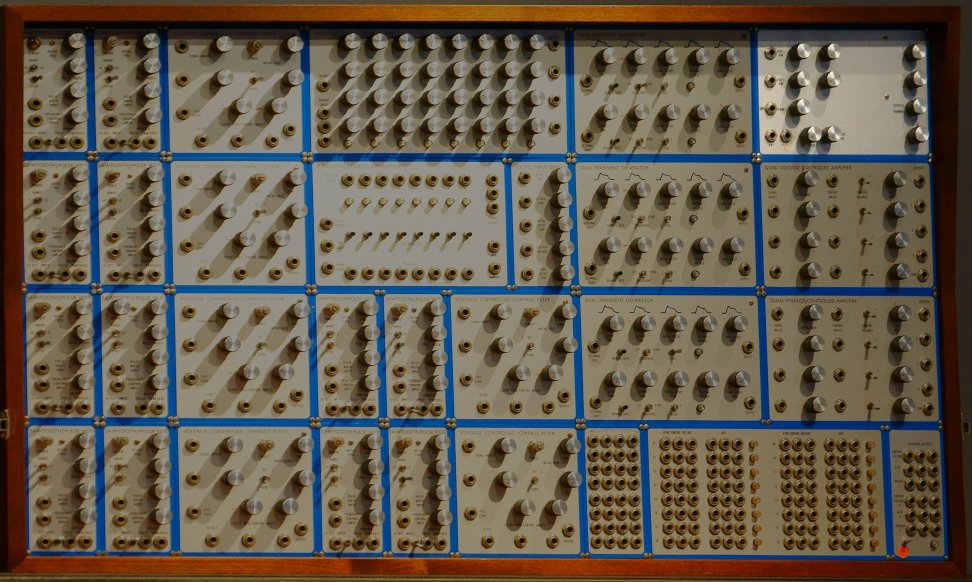
Cabinet #2, highlighting the third unnamed module.
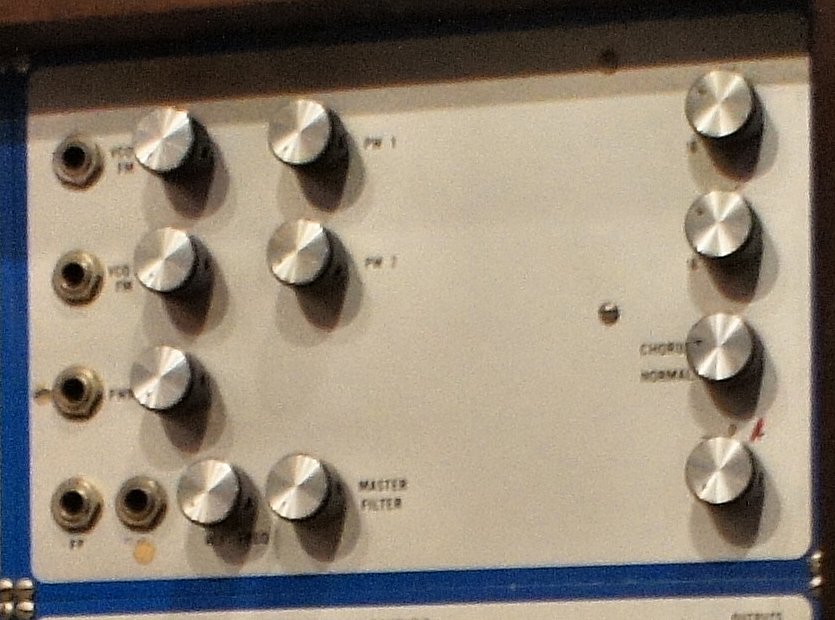
Mystery module 3 - Tommy Mars recalls this as
being a master control for a bank of oscillators
allowing them to be de-tuned to give a chorus
effect.
Update Jan 2012:
The following information was provided by Marco
Alpert, E-mu sales manager for LA at the time:
'As for the modules, given the knobs
labelled with the names of the guitar strings,
the "Output Mixer" is almost certainly a
dedicated output module for the voices
controlled by the 360 Systems unit. I would
normally doubt that it was built by E-mu, as we
never used those knobs for anything, however the
control labelling uses our standard font, so who
knows.
I have no idea what module 1 is, but as you say,
it's almost inconceivable that E-mu would build
anything that looked like that, even as a
one-off.
I believe module 2 is also associated with the
360 Systems controller (maybe 6 individual
string-driven outputs?).
Module 3 is definitely not a standard E-mu
module. Given that is does use the standard
knobs, it could have been built as a custom
module. From the labels I can read, it seems to
have 2 VCO frequency modulation inputs, a pulse
width modulation input, 2 initial pulsewidth
controls and a filter (VCF) frequency control. I
can't read the rest. Since there don't appear to
be any controls for setting initial VCO
frequency, it may be some sort of control
module. (this ties in with Tommy Mars
recollections).'
Alpert added the following comment:
'After just sending that first email, I had
the distinct memory that the 360 Systems guitar
controller that Frank used with his modular was
some integrated unit, not 6 Slavedrivers. A bit
of poking around on the web confirmed that prior
to the Slavedriver, 360 Systems did in fact
produce a (very expensive) polyphonic unit, of
which only three were manufactured. I believe
one of those was Frank's.'
I spoke to Bob Easton who produced the 360
Systems Guitar Synth controller that Marco
Alpert refers to, and he told me:
'Frank used the polyphonic synth, but he
never bought one, and as far as I know it isn’t
on any album of his. The way he played is not
very compatible with the “clean note”
expectation of anybody’s converter—lots of
percussive stuff. ... Maybe Frank used an Emu
when dabbling with it; he had just bought a
pretty large system.'
If any of you synthesizer buffs out
there have any further information regarding the mystery modules
please email me at
Mick@ZappasGear.com
|
